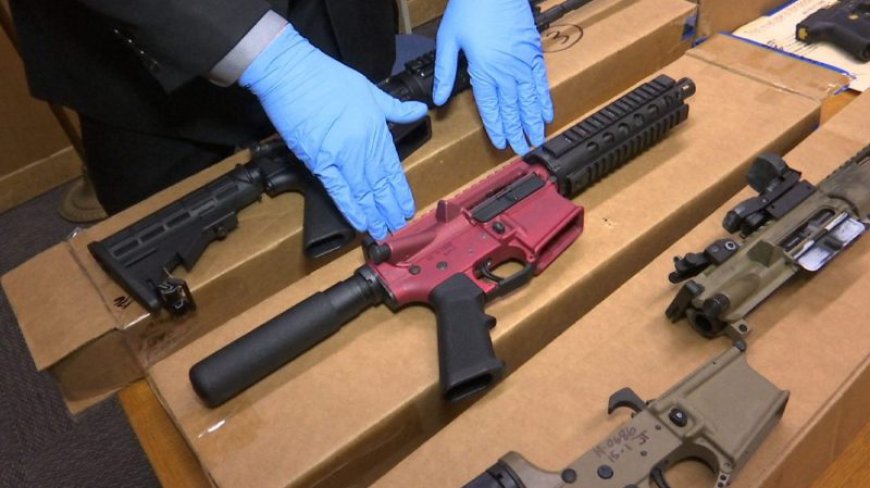What is a ghost gun, like the one found with person of interest in UnitedHealthcare CEO shooting?
Ghost guns have become an emerging public safety threat, targeted at the state and local level for allowing criminals to evade gun regulations.

(The Hill) -- Police said Luigi Mangione, 26, a person of interest in the fatal shooting of UnitedHealthcare CEO Brian Thompson in New York City last week, was arrested Monday with a ghost gun in his possession. Mangione was taken into custody in Altoona, Pa., earlier Monday.
New York City Police Commissioner Jessica Tisch said Altoona police arrested Mangione on firearm charges, after receiving a tip. She said he is believed to be “our person of interest” in Thompson's shooting.
Mangione was reportedly found with a gun, a silencer, false identification cards and identification with his name on it, along with a handwritten manifesto that criticized health care companies, according to multiple outlets.
Joseph Kenny, chief of detectives at the New York Police Department, said Mangione was in possession of a “ghost gun,” which may have been made using a 3D printer, that was capable of firing 9 mm rounds.
Ghost guns have become an emerging public safety threat, targeted at the state and local level for allowing criminals to evade gun regulations.
Here's more about ghost guns.
What is a ghost gun?
A ghost gun is typically sold in a kit and constructed at home without serial numbers or background checks.
Serial numbers would normally allow the guns to be traced back to the manufacturer, the dealer and whoever originally purchased the gun.
Previously unfinished receivers could be legally purchased online without any serial numbers or license, because the government did not previously define an unfinished receiver as a firearm, and the Bureau of Alcohol, Tobacco, Firearms and Explosives (ATF) maintained that it was legal to build your own firearm.
Why are ghost guns raising concerns?
In 2021, the ATF received about 20,000 reports of suspected ghost guns recovered by law enforcement in criminal investigations, up from just more than 1,750 guns recovered in 2016.
Between 2016 and 2021, ATF received 45,240 reports of suspected privately made firearms that had been recovered by officials. Of those, 692 were part of homicide or attempted homicide investigations, the Justice Department said.
In 2022, Attorney General Merrick Garland directed U.S. attorneys to prioritize federal prosecutions of those who illegally sell or transfer firearms used in violent crimes.
What did the Biden administration change?
President Biden in April 2022 announced a ban on unlicensed firearm kits used to manufacture weapons known as ghost guns. The Biden administration’s new policy changed the definition, redefining what a firearm is in order to require that these weapons are serialized and traceable.
What does Biden’s rule change mean, in practice?
The Justice Department said that the new policy “will clarify that parts kits that are readily convertible to firearms are subject to the same regulations as traditional firearms.”
The policy specifically defines what a firearm is, and unfinished parts of a gun must now be licensed with serial numbers. Purchasers must also undergo a background check to buy those items.
These changes effectively mean that federal firearms dealers must put serial numbers on ghost guns. If dealers receive parts without serial numbers, they must add them before selling the gun to someone else. The new rules apply regardless of how the guns are made, including strategies like constructing them from parts, kits and 3D printers.
The National Rifle Association said at the time of the rule's announcement that the move was “yet another hollow plan that will not stop this violence,” and other critics have argued that the policy is extreme, a point Biden countered.
“Is it extreme to protect police officers? Extreme to protect our children? Extreme to keep guns out of the hands of people who couldn’t even pass a background check? The idea that someone on a terrorist list could purchase one of these guns,” the president said.
“It isn’t extreme, it’s just basic, common sense,” he added.
Isn't there a court challenge?
Yes. On Oct. 8, 2024, the Supreme Court heard Garland v. VanDerStok, a landmark case that should determine whether firearm kits can still be held to the same standards as regular firearms, subject to background checks, age requirements and serial numbers.
The Biden administration's regulation was challenged by five gun manufacturers and distributors, two gun rights groups and two individuals, who contend that ghost guns can’t be categorized as a “firearm” as defined under federal law.
“ATF has now exceeded its authority by operating outside of the bounds set by Congress,” Peter Patterson, who represented the challengers, told the justices.
A majority of the court, including the three liberal justices, appeared sympathetic toward the government’s assertion that it wasn’t overstepping its authority.
“The agency just taking over what is really Congress’s business — is that a storyline that the respondents here can tell about this regulation?” asked Justice Elena Kagan.
“No, I don’t think there is any tenable way to characterize this regulation as an attempt to change the meaning of the statute to confront a new problem,” responded U.S. Solicitor General Elizabeth Prelogar.
But not all the justices seemed convinced.
“You make a lot of the fact that this has been regulated for half a century, but it wasn’t regulated in this way for a half century,” conservative Justice Clarence Thomas pressed the government.
What's Your Reaction?

























